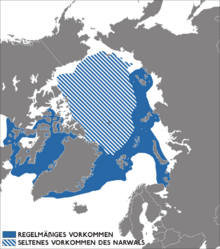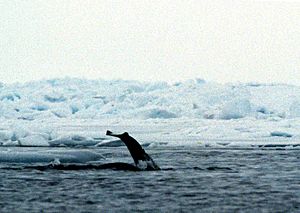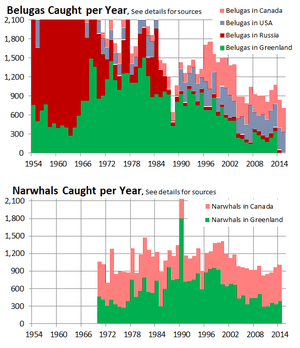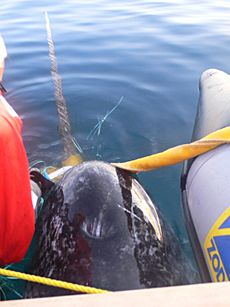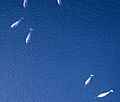Narwhal facts for kids
Quick facts for kids Narwhal |
|
|---|---|
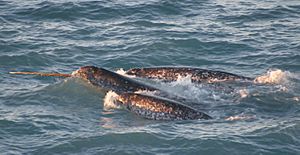 |
|
 |
|
| Size comparison with a human | |
| Scientific classification | |
| Kingdom: | |
| Phylum: | |
| Class: | |
| Order: | |
| Suborder: |
Olphinesa
|
| Family: |
Monodontidae
|
| Genus: |
Monodon
|
| Binomial name | |
| Monodon monoceros Linnaeus, 1758
|
|
The narwhal or narwhale (Monodon monoceros) is a rarely seen Arctic whale. This social whale is known as the "unicorn of the sea" because the male has a very long tusk, which is actually an oversized canine tooth. Narwhal means "corpse whale" in Old Norse.
Contents
Description
Large male narwhals can grow to a length of 15 feet, and weigh up to two tons. A female can give birth once every three years, after a pregnancy of 15 months. At birth, the baby narwhal is about five feet long and weighs about 180 pounds.
All narwhals have two teeth in their upper jaw and a tusk. After the first year of a male narwhal's life, its left tooth grows outward, spirally. There are some narwhals that are double-tusked, but they are not as common. This long, single or double tooth projects from its upper jaw and can grow to be 8.75 feet (2.7 meters) long. Tusks are usually twisted in a counterclockwise direction and are hollow inside. The tusk's function is uncertain, perhaps used as a formidable jousting weapon in courtship and dominance rivalry, in getting food, and/or for channeling and amplifying sonar pulses (which they emit). The tusk is not used in hunting. Long ago, narwhal sightings probably reinforced (or started) the unicorn legends. In fact, when people found the horn of a dead narwhal washed up on shore, they thought that they had found the horn of a unicorn.
Narwhal can dive deep into the sea to around 800 meters, but can also sometimes dive up to 1,500 meters. This makes them one of the deepest diving sea mammals.
Habitat
Narwhals live in the icy waters of the Arctic seas. The Narwhal's thick skin, called blubber, keep them warm in the cold water. They do not go far away from ice. Narwhals live in groups of between 10 and 100. Narwhals are migrating animals who like to move from one place to live in another place for a while. In summer, groups of them move closer to land, where they can sometimes be seen in the estuaries, deep fjords, and bays of Greenland, Northern Canada and as far eastern Russia. In Winter they move back to the icy waters, where they breathe from small holes in the ice.
Narwhals can hunt under ice and like to eat Arctic fish such as the flatfish Greenland halibut, the polar and Arctic cod, shrimp and squid. They suck in their prey when they get close.
Narwhals are both hunted by polar bears and killer whales. The native Inuit people, sometimes called the Eskimos, are still allowed to hunt the Narwhals for their meat and for the tusks. The tusks are sold with or without carving. The annual value received from Narwhal hunts in Hudson Bay is $530,000, of which $370,000 is for meat, $150,000 for tusks, bones and teeth of males, and $10,000 for teeth and bones of females.
Behaviour
Narwhals normally form groups of about five to ten, and sometimes up to 20 outside the summer. Groups may be "nurseries" with only females and young, or can contain only juveniles or adult males ("bulls"), but mixed groups can occur at any time of year. In the summer, several groups come together, forming larger gorups which can contain from 500 to over 1000 whales.
At times, a bull narwhal may rub its tusk with another bull, which is known as "tusking" and thought to maintain social dominance hierarchies. However, this behaviour may exhibit tusk use as a sensory and communication organ for sharing information about water chemistry sensed in tusk microchannels.
Diet
Narwhals have a relatively specialized diet. They prey on Greenland halibut, polar and Arctic cod, cuttlefish, shrimp and armhook squid. Additional items found in stomachs have included wolffish, capelin, skate eggs and sometimes rocks, accidentally ingested when whales feed near the bottom. As long as narwhals have no well-developed teeth in the mouth, they are believed to feed by swimming towards prey until it is within close range and then sucking it with considerable force into the mouth. It is thought that the beaked whales, which have similarly reduced dentition, also suck up their prey.
Diving
When in their wintering waters, narwhals make some of the deepest dives recorded for a marine mammal, diving to at least 800 metres (2,620 feet) over 15 times per day, with many dives reaching 1,500 metres (4,920 feet). Dives to these depths last around 25 minutes, including the time spent at the bottom and the transit down and back from the surface.
Communication
As with most toothed whales, narwhals use sound to navigate and hunt for food. "Clicks", "whistles" and "knocks" may be created via air between chambers near the blow-hole. These sounds are then focused by the animal's melon, which can be controlled by musculature. "Click trains" are produced both for echolocation of prey, and for locating obstacles at short distances.
Breeding and early life
Females start bearing calves when six to eight years old. Adult narwhals mate in April or May when they are in the offshore pack ice. Gestation lasts for 14 months and calves are born between June and August the following year. As with most marine mammals, only a single young is born, averaging 1.6 metres (5.2 feet) in length and white or light grey in color.
Newborn calves begin their lives with a thin layer of blubber which thickens as they nurse their mother's milk which is rich in fat. Calves are dependent on milk for around 20 months. This long lactation period gives calves time to learn skills needed for survival during maturation when they stay within two body lengths of the mother.
Life span and mortality
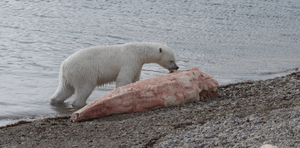
Narwhals can live up to at least 50 years. The narwhals can die of suffocating after they fail to leave before the surface of the Arctic waters freeze over in the late autumn. As narwhals need to breathe, they drown if they cannot reach open water and the ice is too thick for them to break through.
Predation and hunting
Major predators are polar bears, which attack at breathing holes mainly for young narwhals, Greenland sharks, and walruses. Killer whales (orcas) group together to overwhelm narwhal pods in the shallow water of enclosed bays, in one case killing dozens of narwhals in a single attack. To escape predators such as orcas, narwhals may hide under ice floes for a longer time.
Humans hunt narwhals. Inuit are able to hunt this whale species legally. Almost all parts of the narwhal, meat, skin, blubber and organs are consumed. Muktuk, the name for raw skin and blubber, is considered a delicacy. One or two vertebrae per animal are used for tools and art. The skin is an important source of vitamin C which is otherwise difficult to obtain. In some places in Greenland, such as Qaanaaq, traditional hunting methods are used and whales are harpooned from handmade kayaks. In other parts of Greenland and Northern Canada, high-speed boats and hunting rifles are used.
About 1,000 narwhals per year are killed, 600 in Canada and 400 in Greenland. Canadian harvests were steady at this level in the 1970s, dropped to 300-400 per year in the late 1980s and 1990s, and rose again since 1999. Greenland harvested more, 700-900 per year, in the 1980s and 1990s.
Conservation issues
Narwhals are one of many mammals that are being threatened by human actions.
Narwhals are not endangered yet. But they can become enganged or even extinct becuase the climate changes and the natural ice cover of the Artic is melting. The total number of narwhals is estimated at 80,000, according to the World Widlife Fund.
Narwhals are difficult to keep in captivity. In an effort to support conservation, the European Union and the United Stated do not allow to import tusks.
Cultural depictions
In legend

In Inuit legend, the narwhal's tusk was created when a woman with a harpoon rope tied around her waist was dragged into the ocean after the harpoon had struck a large narwhal. She was transformed into a narwhal and her hair, which she was wearing in a twisted knot, became the characteristic spiral narwhal tusk.
Some medieval Europeans believed narwhal tusks to be the horns from the legendary unicorn. As these horns were considered to have magic powers: they could neutralise poison and cure melancholia. Vikings and other northern traders were able to sell them for many times their weight in gold.
The tusks were used to make cups that were thought to negate any poison that may have been slipped into the drink. A narwhal tusk exhibited at Warwick Castle is according to legend the rib of the mythical Dun Cow. In 1555, Olaus Magnus published a drawing of a fish-like creature with a horn on its forehead, correctly identifying it as a "Narwal". During the 16th century, Queen Elizabeth I received a narwhal tusk worth 10,000 pounds sterling—the 16th-century equivalent cost of a castle (approximately £1.5–2.5 million in 2007, using the retail price index)–from Sir Humphrey Gilbert, who proposed that the tusk was from a "sea-unicorne". The tusks were staples of the cabinet of curiosities.
In literature and art
The narwhal was one of two possible explanations of the giant sea phenomenon written by Jules Verne in his 1870 novel Twenty Thousand Leagues Under the Sea. Verne thought that it would be unlikely that there was such a gigantic narwhal in existence. The size of the narwhal, or "unicorn of the sea", as found by Verne, would have been 18.3 m (60 ft). For the narwhal to have caused the phenomenon, Verne stated that its size and strength would have to increase by five or ten times.
Herman Melville wrote a section on the narwhal (written as "narwhale") in his 1851 novel Moby-Dick, in which he claims a narwhal tusk hung for "a long period" in Windsor Castle after Sir Martin Frobisher had given it to Queen Elizabeth. Another claim he made was that the Danish kings made their thrones from narwhal tusks.
Images for kids
-
Narwhals in the Creswell Bay at Somerset Island
-
The head of an Inuit lance made from a narwhal tusk with a meteorite iron blade (British Museum)
See also
 In Spanish: Monodon monoceros para niños
In Spanish: Monodon monoceros para niños


